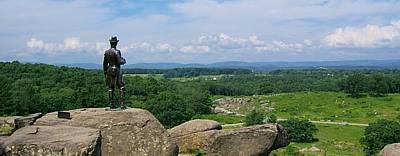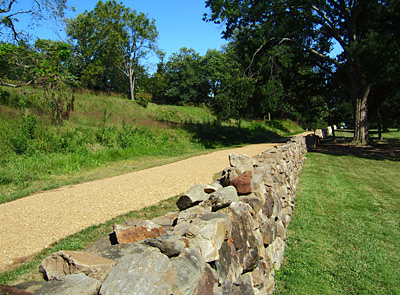With the coming of winter and the corresponding disincentives to travel, I thought I'd mention an option for those who either chose to stay at home but would still like to visit a battlefield or who find themselves confined to the great indoors. Microsoft's Virtual Earth, a feature of their
Live Search, allows for a unique opportunity to tour several of the Nation's Civil War Battlefields without leaving your chair or having the dogs feel neglected. This virtual search allow you to view the battlefields from a perspective ranging from 15 to 60 yards above the ground. The interactive images offer a unique opportunity to study terrain, the layout of the battlefields, or anything else that you might find.
 The Angle at Gettysburg
The Angle at GettysburgI have included a few of the images that I found while canvasing on-line. These are each directly from Virtual Earth. For those with a dial-up connection, please forgive the slow loading time. I uploaded larger images so that people could see the images as they appear on-line. Simply click on any of the ones I've included to see the larger, more interesting version.
For those not familiar with Virtual Earth, I'll give you a quick thumbnail sketch of how to find what you'd like to see. After clicking on the link above (which should open in a separate window or tab so that you can still refer to this article), you should see a map of the United States. Having cookies enabled helps with loading time, especially in Firefox. Once it loads, you can then double click on the sections of the map that you'd like to see (it'll zoom in with each double click). For an easier way to locate sites, enter the location of your choice in the second text box at the top of the screen. It should say, "Enter City, Address, or Landmark". Fortunately, the search engine treats spelling errors kindly as it will, with limited success, attempt to guess your intentions if you're a little off.

When you zoom in on a site that will allow for the "Bird' Eye View" feature, click on the box as seen in the above image. The bird's eye view allows you to zoom in closely on the battlefield and, in some instances, see some pretty decent detail.
 Arlington House at Arlington National Cemetery
Arlington House at Arlington National CemeteryUnfortunately, Virtual Earth does not yet have the Bird's Eye View for all of the Civil War Battlefields. Currently, they include images of Gettysburg, Balls Bluff, Chickamauga, Richmond, Arlington, Washington DC, and Stone Mountain. When viewing Richmond, you can find some nice views of the Tredegar Iron Works (below), and the Hollywood Cemetery. For the latter, if you know the cemetery grounds, you can find the grave sites of Jefferson Davis and George Pickett, among others, and several views of the Confederate pyramid. Virtual Earth only offered limited views of Manassas and just portions of Shiloh. As of my last search, I could not find Bird's Eye View images of Vicksburg, Fredericksburg, Chancellorsville, Chattanooga, Malvern Hill, Cold Harbor, Gaines Mill, Antietam, or Harpers Ferry. They did however have the usual satellite imagery for each of these, but the quality suffers when compared to the other close-ups.
 Tredegar Iron Works, Richmond, VA
Tredegar Iron Works, Richmond, VAWhen zoomed in close, you can more easily navigate the various locations by either dragging the larger image as you would in an Adobe PDF document, or by using the small navigation pane on the left (pictured in the image above). When the dragged image does not refresh, as it tends to avoid doing just when you're getting close to what you want, using the small navigation pane sometimes resolves the issue.
One other interesting feature is the compass (also pictured above) which allows you to view a scene from at least four different directions. When looking at a Bird's Eye image, just click on one of the compass points and it will offer another view. For several sites, such as Stone Mountain, the compass comes in handy since at first Virtual Earth shows it upside down.
Expect to practice a little patience as Virtual Earth at times has difficulty rendering the images or apparently simply deciding if it'll let you see them at all. Using the compass may allow you to see an image that it initially said was not available. Some of the images are perhaps a year or more old since, for example, they still show the car dealership that the National Park Service has since removed from the Battlefield at Gettysburg.
If you decide to have a look, good luck and happy hunting.
Sincerely,
Randy
Please visit my primary site at
www.brotherswar.comAll original material Copyright © 2006. All Rights Reserved
 Edwin Forbes January 25, 1863
Edwin Forbes January 25, 1863









